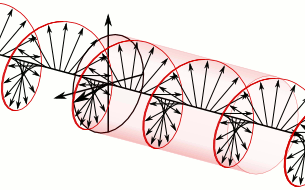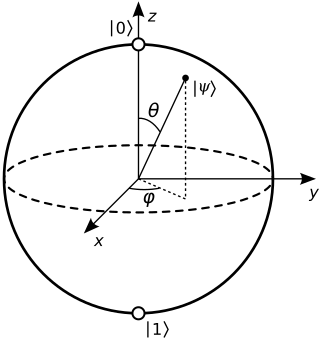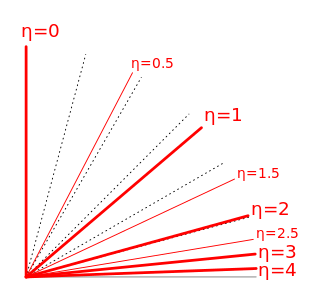Jones vector
The Jones vector describes the polarization of light in free space or another homogeneous isotropic non-attenuating medium, where the light can be properly described as transverse waves. Suppose that a monochromatic plane wave of light is travelling in the positive z-direction, with angular frequency ω and wave vector k = (0,0,k), where the wavenumber k = ω/c. Then the electric and magnetic fields E and H are orthogonal to k at each point; they both lie in the plane "transverse" to the direction of motion. Furthermore, H is determined from E by 90-degree rotation and a fixed multiplier depending on the wave impedance of the medium. So the polarization of the light can be determined by studying E. The complex amplitude of E is written

Note that the physical E field is the real part of this vector; the complex multiplier serves up the phase information. Here  is the imaginary unit with
is the imaginary unit with  .
.
The Jones vector is

Thus, the Jones vector represents the amplitude and phase of the electric field in the x and y directions.
The sum of the squares of the absolute values of the two components of Jones vectors is proportional to the intensity of light. It is common to normalize it to 1 at the starting point of calculation for simplification. It is also common to constrain the first component of the Jones vectors to be a real number. This discards the overall phase information that would be needed for calculation of interference with other beams.
Note that all Jones vectors and matrices in this article employ the convention that the phase of the light wave is given by  , a convention used by Hecht. Under this convention, increase in
, a convention used by Hecht. Under this convention, increase in  (or
(or  ) indicates retardation (delay) in phase, while decrease indicates advance in phase. For example, a Jones vectors component of
) indicates retardation (delay) in phase, while decrease indicates advance in phase. For example, a Jones vectors component of  (
( ) indicates retardation by
) indicates retardation by  (or 90 degree) compared to 1 (
(or 90 degree) compared to 1 ( ). Collett uses the opposite definition for the phase (
). Collett uses the opposite definition for the phase ( ). Also, Collet and Jones follow different conventions for the definitions of handedness of circular polarization. Jones' convention is called: "From the point of view of the receiver", while Collett's convention is called: "From the point of view of the source." The reader should be wary of the choice of convention when consulting references on the Jones calculus.
). Also, Collet and Jones follow different conventions for the definitions of handedness of circular polarization. Jones' convention is called: "From the point of view of the receiver", while Collett's convention is called: "From the point of view of the source." The reader should be wary of the choice of convention when consulting references on the Jones calculus.
The following table gives the 6 common examples of normalized Jones vectors.
| Polarization | Jones vector | Typical ket notation |
|---|
Linear polarized in the x direction
Typically called "horizontal" |  |  |
Linear polarized in the y direction
Typically called "vertical" |  |  |
Linear polarized at 45° from the x axis
Typically called "diagonal" L+45 |  |  |
Linear polarized at −45° from the x axis
Typically called "anti-diagonal" L−45 |  |  |
Right-hand circular polarized
Typically called "RCP" or "RHCP" |  |  |
Left-hand circular polarized
Typically called "LCP" or "LHCP" |  |  |
A general vector that points to any place on the surface is written as a ket  . When employing the Poincaré sphere (also known as the Bloch sphere), the basis kets (
. When employing the Poincaré sphere (also known as the Bloch sphere), the basis kets ( and
and  ) must be assigned to opposing (antipodal) pairs of the kets listed above. For example, one might assign
) must be assigned to opposing (antipodal) pairs of the kets listed above. For example, one might assign  =
=  and
and  =
=  . These assignments are arbitrary. Opposing pairs are
. These assignments are arbitrary. Opposing pairs are
 and
and 
 and
and 
 and
and 
The polarization of any point not equal to  or
or  and not on the circle that passes through
and not on the circle that passes through  is known as elliptical polarization.
is known as elliptical polarization.
Phase retarders
A phase retarder is an optical element that produces a phase difference between two orthogonal polarization components of a monochromatic polarized beam of light. [3] Mathematically, using kets to represent Jones vectors, this means that the action of a phase retarder is to transform light with polarization

to

where  are orthogonal polarization components (i.e.
are orthogonal polarization components (i.e.  ) that are determined by the physical nature of the phase retarder. In general, the orthogonal components could be any two basis vectors. For example, the action of the circular phase retarder is such that
) that are determined by the physical nature of the phase retarder. In general, the orthogonal components could be any two basis vectors. For example, the action of the circular phase retarder is such that

However, linear phase retarders, for which  are linear polarizations, are more commonly encountered in discussion and in practice. In fact, sometimes the term "phase retarder" is used to refer specifically to linear phase retarders.
are linear polarizations, are more commonly encountered in discussion and in practice. In fact, sometimes the term "phase retarder" is used to refer specifically to linear phase retarders.
Linear phase retarders are usually made out of birefringent uniaxial crystals such as calcite, MgF2 or quartz. Plates made of these materials for this purpose are referred to as waveplates. Uniaxial crystals have one crystal axis that is different from the other two crystal axes (i.e., ni ≠ nj = nk). This unique axis is called the extraordinary axis and is also referred to as the optic axis. An optic axis can be the fast or the slow axis for the crystal depending on the crystal at hand. Light travels with a higher phase velocity along an axis that has the smallest refractive index and this axis is called the fast axis. Similarly, an axis which has the largest refractive index is called a slow axis since the phase velocity of light is the lowest along this axis. "Negative" uniaxial crystals (e.g., calcite CaCO3, sapphire Al2O3) have ne < no so for these crystals, the extraordinary axis (optic axis) is the fast axis, whereas for "positive" uniaxial crystals (e.g., quartz SiO2, magnesium fluoride MgF2, rutile TiO2), ne > no and thus the extraordinary axis (optic axis) is the slow axis. Other commercially available linear phase retarders exist and are used in more specialized applications. The Fresnel rhombs is one such alternative.
Any linear phase retarder with its fast axis defined as the x- or y-axis has zero off-diagonal terms and thus can be conveniently expressed as

where  and
and  are the phase offsets of the electric fields in
are the phase offsets of the electric fields in  and
and  directions respectively. In the phase convention
directions respectively. In the phase convention  , define the relative phase between the two waves as
, define the relative phase between the two waves as  . Then a positive
. Then a positive  (i.e.
(i.e.  >
>  ) means that
) means that  doesn't attain the same value as
doesn't attain the same value as  until a later time, i.e.
until a later time, i.e.  leads
leads  . Similarly, if
. Similarly, if  , then
, then  leads
leads  .
.
For example, if the fast axis of a quarter waveplate is horizontal, then the phase velocity along the horizontal direction is ahead of the vertical direction i.e.,  leads
leads  . Thus,
. Thus,  which for a quarter waveplate yields
which for a quarter waveplate yields  .
.
In the opposite convention  , define the relative phase as
, define the relative phase as  . Then
. Then  means that
means that  doesn't attain the same value as
doesn't attain the same value as  until a later time, i.e.
until a later time, i.e.  leads
leads  .
.
| Phase retarders | Corresponding Jones matrix |
|---|
| Quarter-wave plate with fast axis vertical [4] [note 1] |  |
| Quarter-wave plate with fast axis horizontal [4] |  |
Quarter-wave plate with fast axis at angle  w.r.t the horizontal axis w.r.t the horizontal axis |  |
Half-wave plate rotated by  [5] [5] |  |
Half-wave plate with fast axis at angle  w.r.t the horizontal axis [6] w.r.t the horizontal axis [6] |  |
| General Waveplate (Linear Phase Retarder) [3] |  |
| Arbitrary birefringent material (Elliptical phase retarder) [3] [7] |  |
The Jones matrix for an arbitrary birefringent material is the most general form of a polarization transformation in the Jones calculus; it can represent any polarization transformation. To see this, one can show

The above matrix is a general parametrization for the elements of SU(2), using the convention

where the overline denotes complex conjugation.
Finally, recognizing that the set of unitary transformations on  can be expressed as
can be expressed as

it becomes clear that the Jones matrix for an arbitrary birefringent material represents any unitary transformation, up to a phase factor  . Therefore, for appropriate choice of
. Therefore, for appropriate choice of  ,
,  , and
, and  , a transformation between any two Jones vectors can be found, up to a phase factor
, a transformation between any two Jones vectors can be found, up to a phase factor  . However, in the Jones calculus, such phase factors do not change the represented polarization of a Jones vector, so are either considered arbitrary or imposed ad hoc to conform to a set convention.
. However, in the Jones calculus, such phase factors do not change the represented polarization of a Jones vector, so are either considered arbitrary or imposed ad hoc to conform to a set convention.
The special expressions for the phase retarders can be obtained by taking suitable parameter values in the general expression for a birefringent material. [7] In the general expression:
- The relative phase retardation induced between the fast axis and the slow axis is given by

 is the orientation of the fast axis with respect to the x-axis.
is the orientation of the fast axis with respect to the x-axis. is the circularity.
is the circularity.
Note that for linear retarders,  = 0 and for circular retarders,
= 0 and for circular retarders,  = ±
= ±  /2,
/2,  =
=  /4. In general for elliptical retarders,
/4. In general for elliptical retarders,  takes on values between -
takes on values between -  /2 and
/2 and  /2.
/2.






















































































